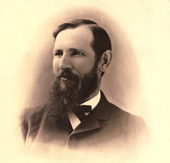Gaumer barbed pocket mouse
| Gaumer barbed pocket mouse | ||||||||||||
|---|---|---|---|---|---|---|---|---|---|---|---|---|
| Systematics | ||||||||||||
|
||||||||||||
| Scientific name | ||||||||||||
| Heteromys gaumeri | ||||||||||||
| JA Allen & Chapman , 1897 |
The Gaumer barbed pocket mouse ( Heteromys gaumeri ) is a species of barbed pocket mouse that is found on the Yucatán peninsula in parts of southeastern Mexico , north of Belize and north of Guatemala .
features
The Gaumer quill pocket mouse reaches an average head-trunk length of 12.5 centimeters for the males and an average of 12.3 centimeters for the females, the weight is 43 to 70 grams. The tail is on average 15.1 or 14.6 centimeters long. The average ear length is 16 millimeters and the average hind foot length is 34 millimeters. It is therefore a medium-sized species of the genus, the males are on average slightly larger than the females. The fur of the adult animal is coarse and contains individual stiffened, soft and spiky hairs on the back and sides of the body. The back fur is orange-sand-colored to gray with clear ocher-colored speckles. On the sides there is a clear and wide ocher-colored band that extends down to the cheeks and legs, the belly is white. The ears are gray-black with a white border.
The front areas of the soles of the hind feet are slightly hairy and have six tubercles. The tail is hairy and two-colored, the top is darker than the bottom and the tip of the tail ends in a distinct tuft of hair. The karyotype consists of a diploid chromosome set of 2n = 56 chromosomes (FN = 76).
In comparison to partially sympatrically occurring Desmarest spiny mouse pocket ( Heteromys desmaresti ) Gaumer the spiny mouse bag in nearly all dimensions is smaller than the relatively large tympanic cavities . In the areas where both species occur, the side line of the Gaumer barbed-pocket mouse is narrower and less pronounced.
distribution
The distribution area of the Gaumer quill pocket mouse is on the Yucatán peninsula in parts of southeastern Mexico in the states of Yucatán , Campeche , Quintana Roo and Tabasco as well as in the north of the bordering states Belize and Guatemala , where the species lives at altitudes from sea level up to about 100 meters .
Way of life
The Gaumer quill pocket mouse lives in different forest habitats in its range. The habitat spectrum ranges from medium-high year-round rainforest areas in the south to drier and deciduous bushes and thorn forests in the north and north-west. The species occurs regularly in agricultural areas and is also found in ruderal areas on the roads and on the edges of sugar cane and corn fields as well as in bushes and thorn bushes on watercourses. In the areas in which it occurs together with the Desmarest barbed pocket mouse, it lives in drier and seasonally leafy forests, while the Desmarest barbed pocket mouse uses the tropical and humid rainforest areas.
The animals are nocturnal and live on the ground, otherwise little information is available about their way of life. They live solitary and likely to form solid territories. The breeding season begins at the end of the dry season in April and continues until the end of the rainy season in January. During this time, the sexually mature females give birth to several litters, each with two to five young.
Systematics

|

|
|
|
Joel Asaph Allen and Frank Michler Chapman described the species in 1897.
|
||
The Gaumer pocket mouse is classified as an independent species within the genus of the pocket mouse ( Heteromys ), which consists of 16 species. The first scientific description comes from Joel Asaph Allen and Frank Michler Chapman from 1897, who they introduced as Heteromys gaumeri from the ruined city of Chichén Itzá on the Yucatán peninsula and named after the animal collector George F. Gaumer .
Apart from the nominate form, no further subspecies are distinguished within the species .
Status, threat and protection
The Gaumer quill pocket mouse is classified as not endangered (least concern) by the International Union for Conservation of Nature and Natural Resources (IUCN). This is justified by the stable population and the frequent occurrence of the species. It occurs in several protected areas.
supporting documents
- ↑ a b c d e f g h i j Gaumer's Spiny Pocket Mouse. In: David J. Hafner: Subfamily Heteromyoninae, Genus Heteromys. In: Don E. Wilson, TE Lacher, Jr., Russell A. Mittermeier (editors): Handbook of the Mammals of the World: Lagomorphs and Rodents 1. (HMW, Volume 6) Lynx Edicions, Barcelona 2016, p. 199. ISBN 978-84-941892-3-4 .
- ^ "Gaumer" In: Bo Beolens, Michael Grayson, Michael Watkins: The Eponym Dictionary of Mammals. Johns Hopkins University Press, 2009; P. 149; ISBN 978-0-8018-9304-9 .
- ^ Heteromys (Heteromys) gaumeri . In: Don E. Wilson , DeeAnn M. Reeder (Eds.): Mammal Species of the World. A taxonomic and geographic Reference. 2 volumes. 3. Edition. Johns Hopkins University Press, Baltimore MD 2005, ISBN 0-8018-8221-4 .
- ↑ Heteromys gamumeri in the endangered Red List species the IUCN 2018 Posted by: F. Reid, E. Vázquez, 2016. Accessed December 27, 2018th
literature
- Gaumer's Spiny Pocket Mouse. In: David J. Hafner: Subfamily Heteromyoninae, Genus Heteromys. In: Don E. Wilson, TE Lacher, Jr., Russell A. Mittermeier (editors): Handbook of the Mammals of the World: Lagomorphs and Rodents 1. (HMW, Volume 6) Lynx Edicions, Barcelona 2016, p. 199. ISBN 978-84-941892-3-4 .
Web links
- Heteromys gamumeri in the endangered Red List species the IUCN 2018 Posted by: F. Reid, E. Vázquez, 2016. Accessed December 27, 2018th
